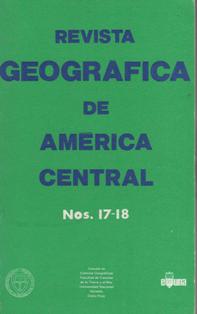ORIGEN Y FLORA DE LAS SABANAS DE LA PROVINCIA DE GUANACASTE (COSTA RICA): UN ANALISIS EN LA FITOGEOGRAFIA HISTORICA
Keywords:
Fitogeografía, sabanas de Guanacaste, factores antropológicosAbstract
El presente artículo de fitogeografía histórica trata de explicar a partir de documentos históricos y relatos de exploradores, buscadores de oro y científicos que recorrieron Costa Rica durante los siglos XVll, XVlll, XlX, el origen y flora de la sabana. Las sabanas de Guanacaste deben su origen a factores antropológicos, edafológicos y climatológicos que actúan en conjunto y no solo al factor antrópico como ha querido explicar. La flora de sabana proviene de la asociación vegetal matorral deciduo por la sequia con especies sempervirentes entremezcladas, cuya florase relaciona con la de las formaciones arbusticas herbáceas secas americanas, llanas y cerradas. Esta flora encuentra las condiciones favorables (fuego anual, larga estación seca, precipitación mal distribuida en el año, etc.) para diseminarse y ocupar el área del bosque seco deciduo por la sequia.
SUMMARY
The present article of historical phytogeography tryst to explain by means of historical documents and commentaries of explorers, goldminers and scientists that traveled in Costa Rica during the 17, 18 and 19 th centuries, the origin of the flora found in the Guanacaste savanna. The Guanacaste savanna owes its origin to a combination of anthropologic, edafologic and climatologic factors; and not only to the anthropologic factor as has been often thought. The savanna type flora originates from the deciduous thicket vegetative association that is common in dry areas intermingled with evergreen species. This type of flora is related to shrub and opens and closed dry Americans herbaceous formations. This flora chooses favorable conditions (burnt off areas, long dry season, poor annual precipitation distribution, etc) in the order to disseminate and occupy the deciduous dry forest.
RESUME
Cet article de phytogéographie historique, à partir de documents historiques, de récits d’explorateurs, de chercheurs d’or ; de scientifiques qui ont parcouru C.R aux XVll, XVlll et XlX siècles, tente d’expliquer l’origine de la savane ainsi que sa flore. On reconnaît que ces origines sont plutôt dûes aux actions conjointes de facteurs anthropologiques, pédologiques et climatiques, au lieu du seul facteur anthropologique comme on voulait l’expliquer auparavant. La savane résulte d’une association végétale : une brousse entremêlée d’espèces « semper virens » malgré l’existence de la saison sèche. Cette flore est en relation avec les informations arbustives et herbeuses –qui caractérisent les dépressions centre américaines- fermées, fonc sèches.
Cette association végétale s’est implantée à la faveur de pratiqués culturales tels les brûlis annuels, des longues saisons sèches et de la répartition irrégulière des pluies au long de l’année, à la place de la forêt claire caducifoliée.
Downloads
How to Cite
Issue
Section
License
Proposed policy for journals offering Open Access
Authors publishing their works in the Journal acknowledge and agree to the following terms:
a) Authors retain the copyrights to their works and guarantee the Journal the right to be the first to publish their works, under the Creative Commons License Attribution-NonCommercial-ShareAlike 4.0 International, CC BY-NC-SA 4.0 International (https://creativecommons.org/licenses/by-nc-sa/4.0/deed.es), which allows others to share works upon complying with the acknowledgment of authorship and mention of the Journal as the original publisher of the work.
b) Authors are permitted to separately establish additional agreements for the non-exclusive distribution of the official edition of the work published in the Journal (for example, authors may desire to place the work in an institutional repository or incorporate it into a book that is to published elsewhere) so long they acknowledgment to recognize the Journal as the original publisher. The aforementioned additional agreements must respect the terms of the non-profit character and sharing philosophy of the original license (CC BY-NC-SA 4.0 International, https://creativecommons.org/licenses/by-nc-sa/4.0/deed.es).
c) Authors are encouraged to archive the post-print or editor/PDF version in Open Access repositories.






 REVGEO is licensed under https://creativecommons.org/licenses/by-nc-sa/4.0/deed.es
REVGEO is licensed under https://creativecommons.org/licenses/by-nc-sa/4.0/deed.es
.svg_4.png)

_(1).png)
_(1)_(1)_(1)_1.png)
(2)(1)(1)(1).png)
